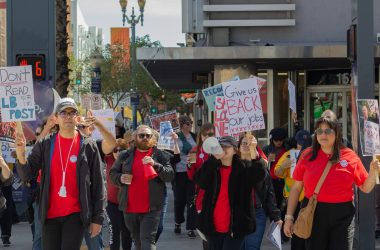The reality of undocumented students differs from those of United States citizens as the opportunities provided are limited – and graduate school is no exception.
From having to reveal immigration status, going through the loops of public and private schools to see how “undocufriendly” they are, to seeking financial resources — undocumented students have to take extra steps when pursuing higher education.
“Undocufriendly” as described by United We Dream, an immigrant youth-led organization, is the term used to refer to schools that have systems and practices that support undocumented students.
While citizens and undocumented students alike share the struggle of application seasons, undocumented students face a more tedious process due to their lack of documentation or the need to provide more documentation to the schools they apply to.
The higher education landscape for undocumented students is challenging, but it has shifted positively with various laws and policies enacted in the last 15 years — particularly AB 540, California’s Development, Relief, and Education for Alien Minors Act and Deferred Action for Childhood Arrivals.
California AB 540 exempts qualifying non-resident students from paying out-of-state tuition.
The California Dream Act allows undocumented students to apply for and receive private scholarships, state financial aid, university grants and community college fee waivers.
DACA defers deportation of eligible undocumented youth and allows them to apply for a work permit.
Kenia Duarte, an undocumented sociology graduate who is currently completing her master’s degree in public policy and administration at CSULB, said she believes an immigration reform would benefit undocumented students.
“The only way I see [undocumented students] getting any higher, any better in getting an education is becoming a U.S. citizen,” she said.
But the only proposed bill that would provide undocumented youth with lawful conditional residency and a pathway to citizenship, the Dream Act has yet to be passed.
The policies and laws previously mentioned do not apply statewide, so depending on the state of residence, a student may be at larger risk of not being admitted into school.
According to a 2015 report by the National Conference of State Legislatures, sixteen states offer in-state tuition rates for undocumented students — California, Colorado, Connecticut, Florida, Illinois, Kansas, Maryland, Minnesota, Nebraska, New Jersey, New Mexico, New York, Oregon, Texas, Utah and Washington.
On the other hand, Arizona, Georgia and Indiana prohibit in-state tuition for undocumented students. Alabama and South Carolina prohibit undocumented students from even enrolling in public postsecondary institution.
Mariela Gutierrez, an undocumented anthropology and Chicano/Latino studies graduate who is now working on her master’s degree in education and social and cultural analysis at Cal State Long Beach, applied to grad school before DACA, thus facing more complicated issues.
For example, in 2012 when contacting Vanderbilt University in Nashville, she was told by a staff member that students with her status couldn’t be accepted — but that wasn’t true.
According to a College Board report, there is no federal or state law that prohibits admission of undocumented students into U.S. colleges.
Gutierrez’s pursuit of a master’s degree took research and consideration of multiple factors when narrowing down her school options.
Some of the factors she looked into were financial support, opinion from students and staff about a specific school and how “undocufriendly” the school was.
“I called the [school] departments and asked — has any undocumented student applied to your school? Do you offer financial aid? And based on that I decided where to go,” she said.
When filling out applications for both the desired program and financial aid, Gutierrez could neither list herself as an international student nor a citizen.
“There were no boxes for me to check,” she said.
Gutierrez, who works closely with students, says that they have to become “resourceful.”
“Look for resources like funding and opportunities to gain skills, networking,” she said, “ [students] have to kick their resourcefulness into full gear.”
Many grad programs require professional experience and look at extracurricular activities that tell more about the applicant.
Letters of recommendation, a resume, a letter of intent and personal statement are also required in the grad school application process.
All of these documents require disclosure of the individual’s personal information and motives, which for an undocumented student, might be crucial to reveal.
Gutierrez has conducted workshops for undocumented students at CSULB as part of her job at the Career Development Center. Among the topics she covers is how to write a personal statement. One of the questions in regard to this issue is whether students should reveal their status.
Duarte believes that California is one of the best states to be in as an undocumented student.
Duarte said she was hesitant to apply to a university for her undergrad studies because her family’s financial situation wasn’t good.
According to a 2014 report published by the Institute for Immigration, Globalization and Education, cost is 87.9 percent the reason why undocumented students don’t attend college. Location and “undocufriendly climate” followed with 64.1 percent and 62.3 percent, respectively.
Compared to Gutierrez’s journey, Duarte’s was easier to navigate thanks to policies that help undocumented students get in-state tuition, such as AB 540.
But regardless of the existing policies, Duarte thinks that advisers weren’t as educated as they are today.
“[Undocumented students] had the career center, but it was the fear of going to talk to that person and say ‘I’m undocumented’ not knowing how they’re going to take it [that kept them from going,]” she said. “And I also think that they weren’t as educated as they are now on the whole undocumented students population. So I didn’t go seek help — I just did it all on my own.”
Duarte said the main reasons why she decided to attend CSULB were because of the proximity and because the undocumented community is so big that there’s never a lack of support.
According to the Public Policy Institute of California, nearly 815,000 undocumented people live in Los Angeles County — more than in any other area of the state.
On campus, Duarte has found support from organizations such as Future Underrepresented Leaders, a student organization that advocates for the rights of undocumented students.
Duarte and Gutierrez believe it’s still hard to find useful information for undocumented students, but progress has been made and other support platforms have risen.
Social media platforms and websites such as My (Un)Documented Life, Undocumedia, United We Dream and Pre-Health Dreamers provide undocumented students with support and useful resources such as scholarship applications and updates on policies and legislatures.
For citizens and undocumented students alike, pursuing a master’s degree is a continuation of their education. Gutierrez says that by the time an undocumented student gets to grad school, he already has some experience in what to do when applying to a particular school.
But Gutierrez believes grad school comes with other difficulties.
“In grad school you have other sets of challenges like it’s much more rigorous, fewer folks of color, let alone undocumented folks,” she said. “Other things come into play, like people talk about impostor syndrome – “should I really be here, am I smart enough, am I capable enough?.”
Although progress has been made, the reality in education continues to be challenging for undocumented students. The biggest solution for them will come from a path to citizenship that will allow them to be fully accepted in their pursuit of higher education.



